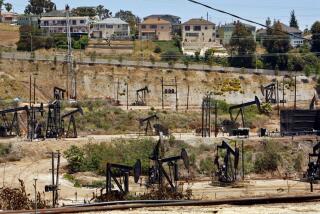Dig a Little Deeper for Energy Answers
One answer to rising gasoline prices lies untapped below existing U.S. oil wells, including many in California. In some cases, the oil left in the ground in abandoned wells amounts to 75% of original reserves. Rather than increasing imports, we should employ better technology to extract more oil from resources previously tapped.
Norway did. When it set out to tap its offshore oil fields, it did so systematically, using technology that visualized underground oil deposits. Drilling and extraction procedures were to maximize production. As a result, Norway recovers at least 40% of its reserves, in some cases as much as 60%.
While Norway’s deposits are relatively easy to tap, other countries with less-promising geology do nearly as well. But in the United States, average production has been less than 30% of reserves. In many cases, the figure is as low as 15%. Worse, many of these producing wells are abandoned -- even though the technology exists to extract the oil economically.
How did this situation occur?
Americans typically think of the oil industry as a few huge corporations. But these companies have, in large measure, left the domestic oil production business. In the U.S., roughly 32,000 small operators, some with only one or two wells, have taken their place.
When oil prices were low and production lagged, many of these operators walked away from their wells. Even when oil prices started rising, these smaller operators, with limited access to capital and faced with the possibility that prices could decline again, were reluctant to make new investments. As a result, the amount of oil recovered from small producing wells has rapidly declined in the last decade.
These resources should not go untapped. For every 1% improvement in recovering existing domestic reserves, we gain 1 billion barrels of oil -- enough to extend the life of domestic production at the current level for a year.
Because of the strategic value of oil resources, we should set a national goal of abandoning no oil field until its reserves have been depleted by 40%.
This may often require manpower and technology investments that small operators cannot afford but would be willing to partly fund. Government should step in as their investment partner in return for a stake as a royalty holder. Such royalty revenues could be invested in research and development in alternative fuels, as well as in oil fields run by small and independent operators.
It’s a win-win situation. The nation receives maximum benefit from its endowed oil resources. We can also further develop our strongest asset -- technological know-how -- by taking on the oil extraction problem. The U.S. government’s investment in agricultural technology, disseminated by a network that reaches the county level, has vastly increased our farm productivity. We can do the same for petroleum productivity.
This approach wouldn’t change the basics of our energy situation. We would remain dependent on oil, much of it imported. Accordingly, we should share our best technology. No matter where scarce natural resources of hydrocarbon are located, generations will benefit from these resources and their byproducts.
Though we are buying time by developing fuel alternatives that can replace oil and gas, surely we must not waste what we have.
More to Read
Sign up for Essential California
The most important California stories and recommendations in your inbox every morning.
You may occasionally receive promotional content from the Los Angeles Times.










